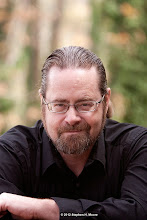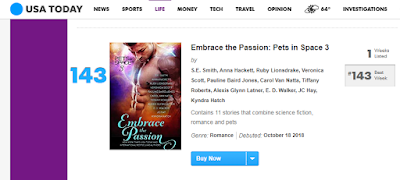 |
| Depositphoto |
(Squints at this week’s topic.) Really? One space or two
after a period??? Well, ok, I started typing at the age of 7 or 8, banging away
on an old Royal typewriter, never took a typing class (which is apparently
where this two spaces thing was taught) so no, I don’t leave two spaces after a
period. Or only by accident LOL.
(Dusts hands.) Done with THAT.
I had an exciting week – Pets
In Space 3 made the USA Today Best Seller’s list, which is the second year
in a row we’ve hit the list with this anthology. My fellow scifi romance
authors and I are very grateful to our readers! We’re about to take the ebook
off the wide distribution, as of October 25th, and go into Kindle
Unlimited on November 1st, which is a new experiment for us regarding the
collection. When the KU period ends after ninety days, the book goes off sale
completely because we only have the rights to the stories for so long. So if
you wanted to buy the ebook so you can read and re-read any time, here are the
links!
Blurb: Pets in Space™ is back! Join us as we unveil
eleven original, never-before-published action-filled romances that will heat
your blood and warm your heart! New York Times, USA Today and Award-winning
authors S.E. Smith, Anna Hackett, Ruby Lionsdrake, Veronica Scott, Pauline
Baird Jones, Carol Van Natta, Tiffany Roberts, Alexis Glynn Latner, E D Walker,
JC Hay, and Kyndra Hatch combine their love for Science Fiction Romance and
pets to bring readers sexy, action-packed romances while helping our favorite charity.
Proud supporters of Hero-Dogs.org, Pets in Space™ authors have donated over
$4,400 in the past two years to help place specially trained dogs with
veterans. Open your hearts and grab your limited release copy of Embrace the
Romance: Pets in Space™ 3 today!
And then, I released the next book in my own scifi romance
series, the Badari Warriors, Timtur:
The Teacher’s Alien Healer, under the In the Stars Romance banner.
The blurb: Genetically engineered soldiers of the far
future, the Badari were created by alien enemies to fight humans. But then the
scientists kidnapped an entire human colony to use as subjects in twisted
experiments…the Badari and the humans made common cause, rebelled and escaped
the labs. Now they live side by side in a sanctuary valley protected by a
powerful Artificial Intelligence, and wage unceasing war on the aliens. The
luckiest Badari find their mates among the humans.
Far from her home in
the human Sectors after the mass kidnapping, teacher Lily Garrison is making a
niche for herself in the valley by running a school for the Badari young.
Although she yearns for Timtur, the pack’s healer, another Badari male has his
eye on her and won’t take no for an answer.
Timtur feels the
weight and responsibility of being the pack’s only healer, constantly on call
as the soldiers fight ferocious battles against the alien scientists and their
troops. With scarcely a moment to himself, he’s drawn to the gentle Lily but
worries he won’t be able to juggle his duties, his loyalty to the pack and a
relationship with a human woman.
When Lily’s stalker
takes direct action to kidnap her and steal her from the safety of the valley,
she’s forced to reach deep inside to find the strength to battle for her life.
Timtur realizes too late how foolish he’s been to resist the bond with his
fated mate and leads the rescue effort.
Before this situation
can be resolved both will have to put their lives on the line and decide what
really matters in a dangerous world ruled by the enemy.
Although this is the
fifth book released in the Badari Warriors scifi romance series, the story of
Timtur and Lily is a standalone and actually comes immediately after book two’s
events.
A tiny teaser
excerpt:
He’s late. I hope he’s
not planning to stand me up entirely.
Despite her concern and annoyance over her date Timtur’s
failure to arrive on time, Lily sat on the flat rock jutting over the serene
lake trying to remain calm. She raised her face to the sky, enjoying the warmth
on her skin. Of course, all too soon she’d get a sun burn and be sorry for her
rash behavior if she remained in the same spot. Red-headed, pale humans had
that problem on every world, not just this one she’d been brought to by alien
pirates as a kidnap victim.
Now she scanned the azure sky with less pleasure, fearing
the sight of enemy flyers, even if this valley was labelled as a sanctuary by
the Badari pack, including Timtur, who’d rescued the humans. Rising, she
retreated to the shady forest glade surrounding the rock formation. The climb
was an easy one, only a few feet, and she made it quickly. Heights were one of
her phobias so she wouldn’t go much higher than this.
Except for the brief moment of savoring the sun’s warmth, on
the whole, she felt safer hidden under the canopy of branches.
The picnic lunch remained in its container, probably still
perfectly fine to eat, but not as delicious as it had been when she packed the
foods in the valley’s communal kitchen a while ago. Winking and nudging her in
the ribs playfully, the head cook made a joke about what big eaters the Badari
warriors were. “Definitely, the way to his heart,” she’d said wisely.
Lily plunked down on the edge of the blue-and-green striped
blanket she’d brought for this special date and knotted the fringe nervously. I can’t use the food to appeal to his heart
if he doesn’t show up. This picnic had been his idea so surely Timtur
wasn’t planning to avoid meeting her. She’d cancelled her afternoon classes to
be free, gotten her hopes up maybe today was the day he’d want to talk about
how he saw them as a couple…I probably
placed too much emphasis on his wanting us to have time alone today, away from
his packmates and my sisters. After all, dating is a totally new concept for
the Badari.
She imagined him placing his strong, healer’s hands on her
body, not just gliding above her skin exercising his special power. When she’d
first arrived, she’d had a relapse of stasis syndrome that defeated the best
efforts of the human doctor in the valley, and Timtur had spent hours
attempting to heal her, monitoring her condition. In the course of the
treatments, the two of them had talked endlessly about every topic under the
sun and grown close. Of course, she’d fallen hard for her handsome healer. She
wasn’t sure if he felt the same way.
Opening her eyes, she sighed. The healer was something
special all right but, despite her best efforts to let him know how interested she was in taking their relationship
further than friendship, he always held back. He didn’t show any interest in
any of the other human women now living in the valley. She had no rivals for
his affections. But still there was something
keeping them from going to the next level, and today was the day she wanted to
discover what the impediment was.
Which was going to be impossible if Timtur didn’t even bother
to show up.
Should I give up on ever
being more than friends? The idea of never seeing where their relationship
could go, never exploring the deep emotional bond she felt with him brought a
wave of cold sadness, and she shivered despite the warmth of the sun. Cutting
herself off from contact with Timtur would break her heart, not cure her of
desire for him.
“Dreaming again?” His
voice, deep and full of good humor, came from behind and to the left.












